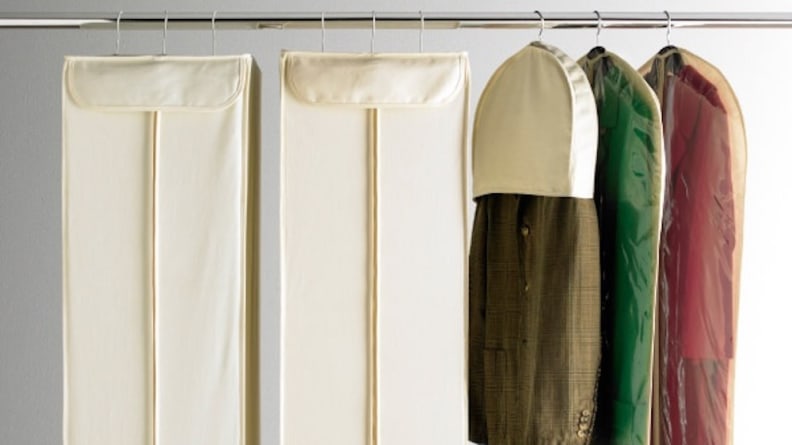LATEST FINANCIAL NEWS
7 tips on how to store seasonal clothing
Autumn is by far my favorite season, so I eagerly await the end of summer when I can pack up all my warm-weather clothes and populate my closet with sweaters and knee-high boots.
Storing seasonal clothing may seem like a simple task—just throw them in a bin and call it a day, right? But a lot of people make some major mistakes that can ultimately harm their clothing. Unless you want to be wearing smelly, moldy, or even holey tank tops and shorts next year, it’s important to store your summer wardrobe the right way.
So go ahead, grab your pumpkin spice latte and get ready to take notes on these seven essential clothing storage tips.
1. Wash your clothes first
Credit: Camco
Wash clothes before you put them in storage.
Anything that’s being removed from your closet should be washed before it goes into storage. This will get rid of dirt, dust, and grime that might be lingering on the fabric, helping to prevent stains and discoloration and keeping your clothes smelling fresh throughout the winter.
Plus, this will allow you to assess and treat any lingering stains you may have forgotten about. If you accidentally pack away a dress with a food stain, it may very well attract pests that can wreak havoc on your entire wardrobe.
2. Donate unworn items

Credit: Savers
Stores like Savers accept gently-used clothing donations.
As you’re going through and washing your summer clothes, you may as well put together a donation box of items you don’t want or haven’t worn. Every time I switch my wardrobe over, I always find one or two items that never saw the light of day, signaling it’s time to let them go.
Personally, I drop off unwanted clothing at my local Salvation Army, but you could also give them to Savers, Goodwill, or another local charity. Some organizations will even come and get your donations right from your front steps. Just remember that donated clothing should always be clean, un-soiled, and lightly worn.
3. Decide whether to fold or hang

Credit: The Container Store
Delicate items should be hung up in garment bags.
Most summer clothing—shorts, tank tops, sundresses, and light shirts—can be folded up and stored through the winter. However, more delicate or fancier items may need to be stored in garment bags. You’ll also want to ensure you have padded hangers to prevent awkward shoulder lumps.
Take the time to separate out any items that should be stored hanging up—generally things like expensive dresses, suits, and other formal wear—then invest in garment bags for them. The best bags are made from cloth instead of plastic, as the latter material traps moisture and can lead to mold or mildew growth.
Get Natural Cotton Hanging Storage Bags from The Container Store for $19.99-$27.99
4. Invest in the right containers

Credit: ClosetMaid
Under-bed storage is ideal for apartments will limited space.
As for the rest of your clothes, you’ll want to pack them up in storage containers—there are a wide variety of styles to choose from, including both cloth bags and plastic bins, like our favorite underbed storage solutions. Generally speaking, cloth containers are better for long-term storage, as they let your clothes breathe, but you might prefer a plastic option if your home is prone to pests—mice will make quick work of a cloth bag!
The best option for you will also depend on where you plan to keep your seasonal clothing. If you’re pressed for storage space, you may want to look for under-the-bed containers or even vacuum-seal bags. If you have an extra closet where you store summer clothes, you might prefer larger plastic stacking bins.
Get the Sterilite Ultra 66-Qt. Storage Box with Wheels 4-Pack on Amazon for $89.13
5. Don’t overpack your bins
It’s tempting to stuff as many garments as possible into each bin, but this can hurt you in the long run. If the bag doesn’t zip or the lid doesn’t fit tightly, you’re allowing room for pests to get in, and if you try to zip an overstuffed bag, it may end up ripping the seams.
If you’re running out of room and don’t have any storage bins left, try rolling up items like pants and shirts before stashing them away—it saves space and prevents wrinkles. Win-win.
6. Include pest repellents

Credit: Cedar Space
Cedar balls will keep pests away from your clothing.
Pests like moths and beetles are crafty, and they sometimes they manage to worm their way into your storage, even if you think the bins are sealed tightly.
For this reason, it’s best to include a moth repellent in each container of clothing—one of the safest options is cedar, a natural insect deterrent. It will leave your clothes smelling fresh, too! This set of cedar balls is highly rated, super affordable, and chemical-free, and with 50 balls, you can cover a lot of ground adding 3-4 balls to each bin (1-2 should do the trick for a garment bag).
Get 50 Cedar Balls on Amazon for $14.90
6. Carefully consider storage locations

Credit: Rubbermaid
Avoid storing clothes in damp locations.
Finally—and arguably most importantly—you need to pick the proper spot to store your containers of clothing. This is where a lot of people go wrong, as they just toss the bins in their attic, basement, or garage. All of these locations are prone to moisture and pests, both of which can harm your stored items. You’ll also want to keep bins out of direct sunlight, which can fade the color and weaken the structure of some fabrics.
The best location to store extra clothing is somewhere dark, cool, and dry—such as in a spare closet or under your guest bed. If you have a lot of hanging items, you may want to invest in a dedicated garment rack. Some models even come with covers for an added layer of protection.
When you follow these steps, your clothes will stay in pristine condition throughout the winter, and they’ll be fresh and ready to wear when the summer weather rolls around again.
The product experts at Reviewed have all your shopping needs covered. Follow Reviewed on Facebook, Twitter, and Instagram for the latest, deals, product reviews, and more.
Prices were accurate at the time this article was published but may change over time.









